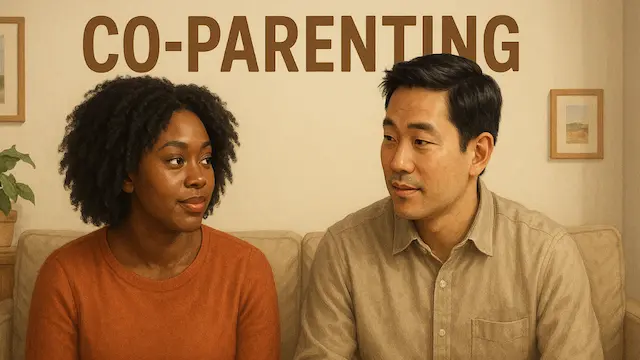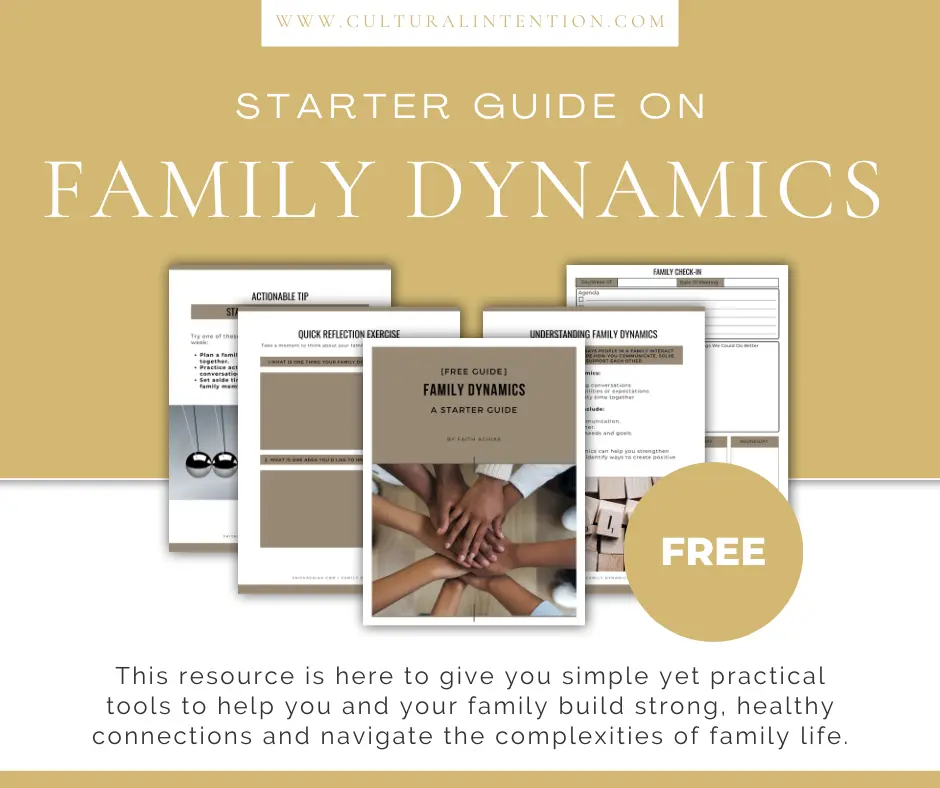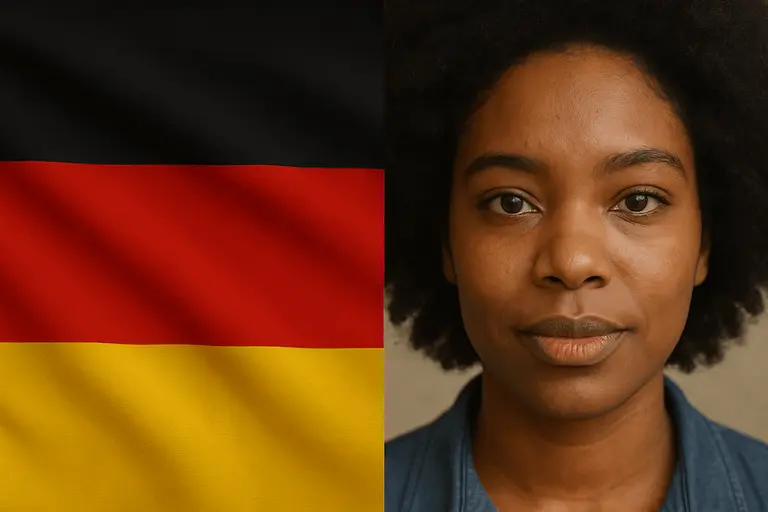Multicultural Couples Parenting Together: Tips for Raising Confident and Connected Kids

What happens when you and your partner were raised with different cultural values, but now you’re raising kids together?
For many couples today, parenting is about more than passing down what you know.
It’s about blending two backgrounds, respecting where you both came from, and figuring out how to raise children in a home where multiple cultures are part of everyday life.
Whether you're navigating language differences, family expectations, or different traditions around holidays and discipline, cultural diversity shapes the way we guide our children.
It can become one of the strongest foundations for multicultural couples' parenting and your family when approached honestly and respectfully.

Ready to Create More
Peace and Connection at Home?
Download your FREE starter guide on Family Dynamics to create healthy communication, build stronger bonds, and navigate challenges with intention.
Cultural Diversity Shapes How We Parent
No two families raise children the same way, especially when parents bring different cultural experiences into the home.
Our parenting choices are shaped by how we were raised, what we believe, and what we hope for our children.
That often means more decisions, conversations, and opportunities to learn together in multicultural homes.
Even in our home, my husband and I were raised in Ghanaian households abroad – mine in Germany.

It might seem like we’d approach parenting the same way on paper. And in many ways, we do.
I hoped and prayed for that. But there are also moments, small and unexpected, when we realize just how differently we see things when it comes to parenting.
Now imagine what that looks like for couples who come from entirely different countries, languages, or belief systems, where nearly everything has to be discussed, decided, and sometimes even translated. The learning runs even deeper.
Understanding the Meaning of Cultural Diversity
Cultural diversity means we come from different backgrounds, shaped by language, customs, beliefs, and lived experiences.
In many families, this shows up when each parent brings their own way of doing things, whether it's how they show affection, discipline, or celebrate milestones.
These differences might appear in everyday details, such as how elders are greeted, what meals are shared, or how birthdays are celebrated and cultural holidays are remembered.
For kids, this often means experiencing more than one language, more than one tradition, and more than one set of values at home.
When parents take the time to respect and share their individual cultures, children grow up feeling connected to both. That layered identity becomes part of their strength.

Why Cultural Awareness Matters in Parenting
Children notice differences early on. When we, as parents, actively teach our kids to value and respect those differences, they grow up more confident in themselves and more open to others.
I see that with our kids, who often approach people and ask about their backgrounds, curious about how things are done in other homes.
It’s not just politeness; it’s genuine interest. That kind of curiosity comes from what they see modeled at home.
In a multicultural marriage or relationship, that awareness begins at home.
It's modeled in how you and your partner speak to one another, share your stories, and make space for both backgrounds.
How It Shows Up at Home
- Sharing stories from both family lines
- Cooking favorite meals from each parent’s heritage
- Speaking or teaching both languages, even at basic levels
- Showing your kids that there’s more than one “right way” to do things
Even small acts, like explaining why one parent greets with a bow while the other doesn’t, help kids understand their cultural world.

Parenting Styles Are Shaped by Culture
One of the biggest challenges for multicultural couples parenting is realizing how deeply culture influences our journey.
What one parent sees as “normal” may feel unfamiliar or uncomfortable to the other.
Different Approaches, Same Love
One parent might value strict routines, while the other leans toward flexibility.
One might expect a child to greet elders with formal respect, while the other emphasizes direct communication.
These aren't right or wrong approaches; they're reflections of culture.
Talking through these differences as a couple doesn’t just bring clarity; it builds trust and models teamwork for your kids.
My parents are more liberal in my upbringing. We talked about everything, so much that sometimes I had to let them know I had heard enough.

I could tell them when I felt something was unfair, and yes, we had arguments.
But I’ve learned over time that that kind of openness isn’t always seen as normal in our culture.
Some might even label it dysfunctional because it doesn’t follow the cultural norm. Still, it works for us.
I’m grateful I wasn’t raised in an overly authoritative household; it gave me space to speak up, and I carry that into how I parent today.
My husband, on the other hand, was raised more traditionally and conservatively, which many would consider the more common approach in our culture.
So, naturally, we’ve had to learn how to meet in the middle.
Parenting as a Multicultural Couple Takes Intention
When you’re parenting across cultures as a couple, intention matters.
You can’t assume your partner sees things the same way, and that’s okay.
Partnership in and of itself can be hard enough at times, and adding cultural differences brings an extra layer that requires even more patience, communication, and grace.
Your shared commitment to learning from each other and building something new together is what truly matters.

Tips for Parenting as a Cross-Cultural Team
- Talk about what matters to each of you. What parenting values do you each hold dear? Where can you compromise?
- Blend traditions gradually. You don’t have to do it all at once. Find what fits naturally, then grow from there.
- Let your kids see unity in diversity. When they see their parents respecting each other’s roots, it teaches them to do the same.
- Give space for trial and error. There is no manual. You’re building something unique, and that takes time.
Raising Children in Multicultural Homes
Your home is likely the first place your child will learn about cultural identity, and you have the chance to make that learning meaningful.
Ways to Support Their Identity
- Introduce both cultures early and often
- Use books, songs, or family traditions to share stories
- Celebrate both cultures on holidays, or create new ones together
- Explain why things are done differently on each side of the family
Let them ask questions. Let them explore. And remind them that they don’t have to pick one side, they belong to both.

Common Challenges and What Helps
Blending two cultures while raising kids can be beautiful and yet hard. You may feel pulled between extended family expectations, religious practices, or different views on discipline and affection.
When Bias or Stereotypes Show Up
Kids may face stereotypes or hear confusing comments about their background. Sometimes, the comments are direct, like being left out or questioned.
Other times, it’s subtle, like someone laughing at their or their family’s accent, making them feel like an outsider, especially after trying so hard to fit in.
Our job as parents isn’t to protect them from every moment, but to prepare them.
- Talk openly about bias and fairness.
- Teach them how to respond with truth and respect
- Choose media that reflects their story and others’
Balancing Both Cultures in the Home
Balance doesn’t always mean doing everything equally. It means valuing each culture in ways that feel right for your family.
In some seasons, one tradition may take the lead. Other times, you might invent new rituals that combine both heritages.
What matters is that your child feels connected to where they come from—and to both of you.

3 Benefits of Embracing Cultural Diversity as a Parenting Team
1. It Builds Empathy
When children grow up in homes that honor multiple cultures, they learn to listen, ask better questions, and understand that there’s more than one way to see the world.
2. It Strengthens Your Partnership
Working through cultural differences together deepens your relationship. You’re not just raising kids, you’re learning, unlearning, and relearning side by side.
3. It Prepares Kids for a Global Life
The world they’ll grow up in is diverse. Your home gives them a head start by helping them understand themselves, value others, and build strong, respectful relationships.

When parents from different backgrounds raise children with intention, they blend more than cultures. They build bridges between histories, values, and everyday decisions.
Your child’s identity strengthens when mutual respect, honest conversations, and steady love from both parents shape it.
You don’t have to be perfect. What matters is your willingness to show up, learn together, and create a home that reflects both of you.
This kind of parenting takes effort. And if you’re reading this, you’re likely one of the parents choosing to do that work.
You’re not just raising a child. You’re passing on a story and writing a new one together.
IF THIS POST SPOKE TO YOU, EXPLORE MORE OF THE JOURNEY ON OUR SITE.
You'll find free guides, intentional tools, and reflections to support cultural growth and legacy-building.
💬 Looking for connection? Join our Facebook community to continue the conversation.
📌 Pin an image to revisit or share with someone walking a similar path.
Thank you for being here.









